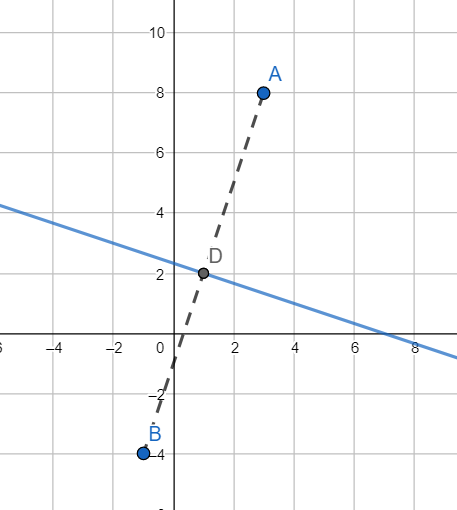
Find the image of the point (3,8) about the line x+3y = 7 assuming the line to be a plane mirror.
Answer
503.1k+ views
Hint: Assume the coordinates of the reflection point be B(x,y). Use the fact that the image distance is equal to object distance. Use the fact that the line joining object to the image is orthogonal to the reflecting surface. Hence form two equations in x and y. Solve for x and y. Hence find coordinates of B.
Alternatively, use the fact that the image of $A\left( {{x}_{1}},{{y}_{1}} \right)$ in the line mirror $ax+by+c=0$ is given by
$\dfrac{h-{{x}_{1}}}{a}=\dfrac{k-{{y}_{1}}}{b}=-2\dfrac{a{{x}_{1}}+b{{y}_{1}}+c}{{{a}^{2}}+{{b}^{2}}}$, where h,k are the coordinates of the image.
Complete step-by-step solution -

Let the coordinates of the image be B(x,y) and let the line AB intersect the line mirror at D.
Since image distance is equal to object distance, we have AD = DB
Hence $\dfrac{AD}{DB}=1$
Hence D is the midpoint of AB.
Now we know that coordinates of the midpoint of AB, where $A\equiv \left( {{x}_{1}},{{y}_{1}} \right)$ and $B\equiv \left( {{x}_{2}},{{y}_{2}} \right)$, are given by
$\left( \dfrac{{{x}_{1}}+{{x}_{2}}}{2},\dfrac{{{y}_{1}}+{{ y }_{2}}}{2} \right)$
Here ${{x}_{1}}=h,{{x}_{2}}=3,{{y}_{1}}=k$ and ${{y}_{2}}=8$
Hence $D\equiv \left( \dfrac{h+3}{2},\dfrac{k+8}{2} \right)$
Since D lies on the line mirror, we have
$\dfrac{h+3}{2}+3\left( \dfrac{k+8}{2} \right)=7\Rightarrow h+3k+13=0\text{ (i)}$.
Also, AB and the line mirror are perpendicular to each other.
Slope of AB $=\dfrac{k-8}{h-3}$
Slope of mirror $=\dfrac{-1}{3}$
We know that if the slopes of two perpendicular lines are ${{m}_{1}}$ and ${{m}_{2}}$ then ${{m}_{1}}{{m}_{2}}=-1$
Hence we have
$\begin{align}
& \dfrac{k-8}{h-3}\left( \dfrac{-1}{3} \right)=-1 \\
& \Rightarrow \dfrac{k-8}{h-3}=3 \\
& \Rightarrow k=3h-1\text{ (ii)} \\
\end{align}$
Substituting the value of k from equation (ii) in equation (i), we get
$\begin{align}
& h+3\left( 3h-1 \right)+13=0 \\
& \Rightarrow 10h+10=0 \\
& \Rightarrow h=-1 \\
\end{align}$
Substituting the value of h in equation (ii), we get
$k=3\left( -1 \right)-1=-4$
Hence the coordinates of the image are given by (-1,-4).
Note: Alternative Solution:
We know that the image of $A\left( {{x}_{1}},{{y}_{1}} \right)$ in the line mirror $ax+by+c=0$ is given by
$\dfrac{h-{{x}_{1}}}{a}=\dfrac{k-{{y}_{1}}}{b}=-2\dfrac{a{{x}_{1}}+b{{y}_{1}}+c}{{{a}^{2}}+{{b}^{2}}}$, where h,k are the coordinates of the image.
Here $a=1,b=3,c=-7,{{x}_{1}}=3$ and ${{y}_{1}}=8$
Hence we have
$\begin{align}
& \dfrac{h-3}{1}=\dfrac{k-8}{3}=-2\left( \dfrac{3+3\left( 8 \right)-7}{{{1}^{2}}+{{3}^{2}}} \right) \\
& \Rightarrow h-3=\dfrac{k-8}{3}=-4 \\
\end{align}$
Hence $h=-4+3=-1$ and $k=8-12=-4$
Hence the coordinates of the image are given by
(-1,-4), which is the same as obtained above.
Alternatively, use the fact that the image of $A\left( {{x}_{1}},{{y}_{1}} \right)$ in the line mirror $ax+by+c=0$ is given by
$\dfrac{h-{{x}_{1}}}{a}=\dfrac{k-{{y}_{1}}}{b}=-2\dfrac{a{{x}_{1}}+b{{y}_{1}}+c}{{{a}^{2}}+{{b}^{2}}}$, where h,k are the coordinates of the image.
Complete step-by-step solution -

Let the coordinates of the image be B(x,y) and let the line AB intersect the line mirror at D.
Since image distance is equal to object distance, we have AD = DB
Hence $\dfrac{AD}{DB}=1$
Hence D is the midpoint of AB.
Now we know that coordinates of the midpoint of AB, where $A\equiv \left( {{x}_{1}},{{y}_{1}} \right)$ and $B\equiv \left( {{x}_{2}},{{y}_{2}} \right)$, are given by
$\left( \dfrac{{{x}_{1}}+{{x}_{2}}}{2},\dfrac{{{y}_{1}}+{{ y }_{2}}}{2} \right)$
Here ${{x}_{1}}=h,{{x}_{2}}=3,{{y}_{1}}=k$ and ${{y}_{2}}=8$
Hence $D\equiv \left( \dfrac{h+3}{2},\dfrac{k+8}{2} \right)$
Since D lies on the line mirror, we have
$\dfrac{h+3}{2}+3\left( \dfrac{k+8}{2} \right)=7\Rightarrow h+3k+13=0\text{ (i)}$.
Also, AB and the line mirror are perpendicular to each other.
Slope of AB $=\dfrac{k-8}{h-3}$
Slope of mirror $=\dfrac{-1}{3}$
We know that if the slopes of two perpendicular lines are ${{m}_{1}}$ and ${{m}_{2}}$ then ${{m}_{1}}{{m}_{2}}=-1$
Hence we have
$\begin{align}
& \dfrac{k-8}{h-3}\left( \dfrac{-1}{3} \right)=-1 \\
& \Rightarrow \dfrac{k-8}{h-3}=3 \\
& \Rightarrow k=3h-1\text{ (ii)} \\
\end{align}$
Substituting the value of k from equation (ii) in equation (i), we get
$\begin{align}
& h+3\left( 3h-1 \right)+13=0 \\
& \Rightarrow 10h+10=0 \\
& \Rightarrow h=-1 \\
\end{align}$
Substituting the value of h in equation (ii), we get
$k=3\left( -1 \right)-1=-4$
Hence the coordinates of the image are given by (-1,-4).
Note: Alternative Solution:
We know that the image of $A\left( {{x}_{1}},{{y}_{1}} \right)$ in the line mirror $ax+by+c=0$ is given by
$\dfrac{h-{{x}_{1}}}{a}=\dfrac{k-{{y}_{1}}}{b}=-2\dfrac{a{{x}_{1}}+b{{y}_{1}}+c}{{{a}^{2}}+{{b}^{2}}}$, where h,k are the coordinates of the image.
Here $a=1,b=3,c=-7,{{x}_{1}}=3$ and ${{y}_{1}}=8$
Hence we have
$\begin{align}
& \dfrac{h-3}{1}=\dfrac{k-8}{3}=-2\left( \dfrac{3+3\left( 8 \right)-7}{{{1}^{2}}+{{3}^{2}}} \right) \\
& \Rightarrow h-3=\dfrac{k-8}{3}=-4 \\
\end{align}$
Hence $h=-4+3=-1$ and $k=8-12=-4$
Hence the coordinates of the image are given by
(-1,-4), which is the same as obtained above.
Recently Updated Pages
Master Class 11 Accountancy: Engaging Questions & Answers for Success

Glucose when reduced with HI and red Phosphorus gives class 11 chemistry CBSE

The highest possible oxidation states of Uranium and class 11 chemistry CBSE

Find the value of x if the mode of the following data class 11 maths CBSE

Which of the following can be used in the Friedel Crafts class 11 chemistry CBSE

A sphere of mass 40 kg is attracted by a second sphere class 11 physics CBSE

Trending doubts
10 examples of friction in our daily life

One Metric ton is equal to kg A 10000 B 1000 C 100 class 11 physics CBSE

Difference Between Prokaryotic Cells and Eukaryotic Cells

State and prove Bernoullis theorem class 11 physics CBSE

What organs are located on the left side of your body class 11 biology CBSE

The combining capacity of an element is known as i class 11 chemistry CBSE




